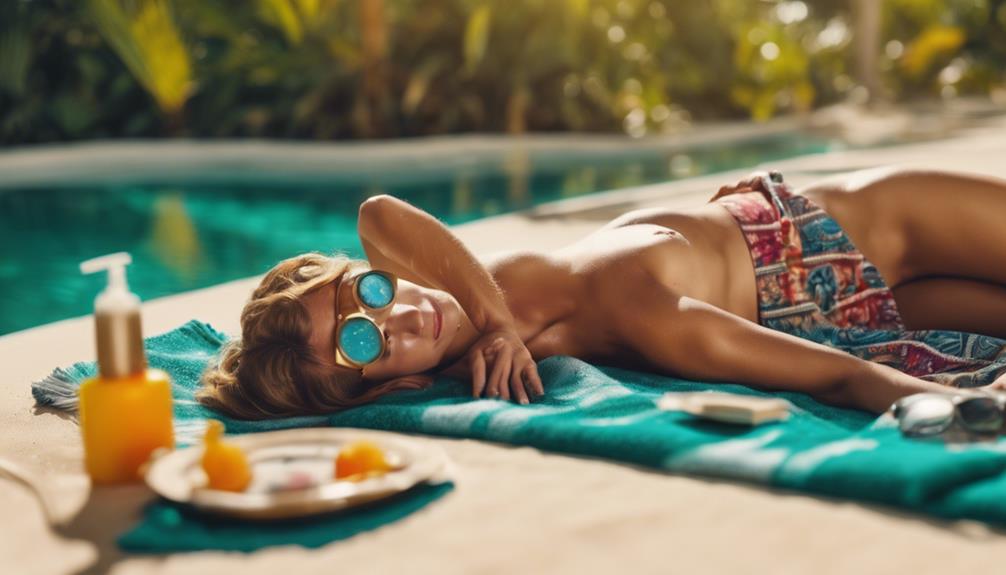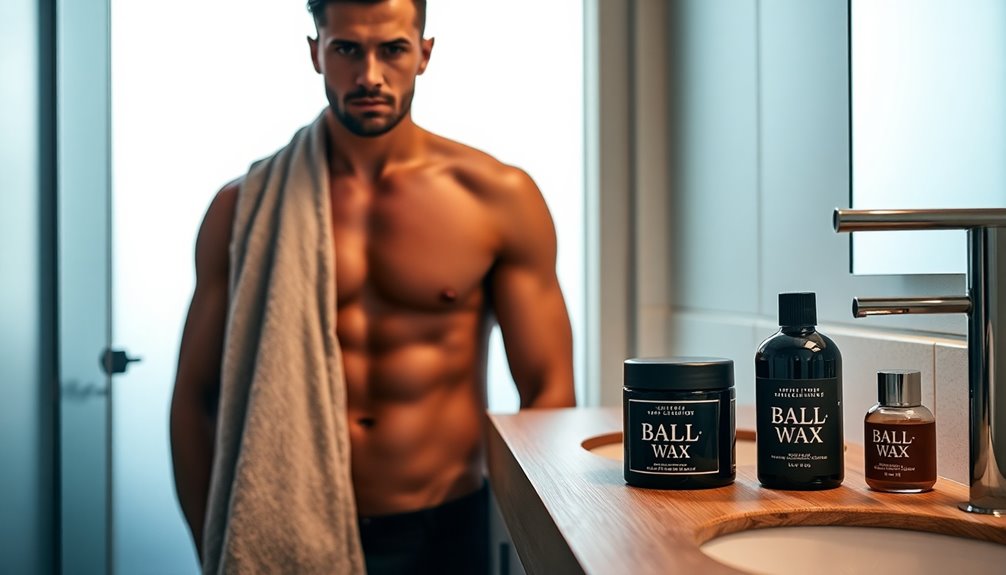In order to achieve the best tan possible and avoid looking like a cooked lobster, it is essential to space out your tanning sessions! It is crucial to allow your skin time to recover. If you have fair skin, start with shorter sessions and then wait at least 24-48 hours before your next one. This will allow your melanin to gradually deepen your tan while also keeping your skin safe. Think of it like baking a cake; if you rush it, you might burn it! Keep track of your progress, and you will achieve that perfect sun-kissed glow. There is even more valuable information to learn ahead!
Key Takeaways
- Always allow 24-48 hours between tanning sessions to let your skin recover and minimize damage.
- Start with shorter sessions to prevent overwhelming your skin and gradually increase duration over time.
- Monitor your skin's reactions during sessions to adjust frequency and duration accordingly.
- Daily moisturizing helps maintain your tan and supports skin health between sessions.
Know Your Skin Type
Understanding your skin type is essential for developing a safe and effective tanning strategy that maximizes your results. Think of your skin like a unique fingerprint; it's special and requires personalized care!
You might fall into one of the Fitzpatrick skin types, ranging from very fair to deeply pigmented. If you burn easily, you're likely on the fair side, while those with deeper tones may tan more easily. Knowing this helps you tailor your tanning sessions—short and sweet for fair skin, longer for darker tones.
So, what's your skin type? Remember, every time you step into the sun or a tanning bed, listen to your skin. It'll give you hints about what it loves and what it doesn't.
Happy tanning!
Understand Melanin Production

Melanin production plays a significant role in how your skin reacts to UV exposure, influencing your tanning experience and results. When you soak up some sun, your skin's melanocytes kick into action, producing melanin as a natural defense. Think of melanin as your skin's sunscreen, helping to protect against damage while giving you that sought-after tan. Here's a quick overview of how melanin works:
| Stage | Description | Importance |
|---|---|---|
| UV Exposure | Skin gets exposed to UV light | Triggers melanin production |
| Melanocyte Activation | Melanocytes start producing melanin | Creates your tan |
| Tan Development | Melanin oxidizes over time | Deepens the tan |
| Skin Recovery | Time between tanning sessions | Prevents burns and damage |
Frequency of Tanning Sessions

Finding the right frequency for your tanning sessions is essential to achieving a beautiful tan while minimizing skin damage. You don't want to end up looking like a lobster, right?
Here's how to space out your sessions for the best results:
- Know your skin type: Fair skin needs more time between sessions.
- Start slow: Begin with shorter sessions, letting your skin adjust.
- Wait 24-48 hours: Give your skin time to recover and develop melanin.
- Consult the pros: Ask the tanning facility staff for personalized advice.
Importance of Session Duration

Session duration plays an essential role in achieving a safe and effective tan, ensuring that your skin has the right amount of exposure without risking damage.
Think of your skin like a sponge—too much water at once and it gets overwhelmed! Instead, you want to soak it up gradually. Starting with shorter sessions lets your skin adjust and builds that beautiful melanin layer without burns.
You might even find it fun to track your progress! Remember, waiting 24 to 48 hours between sessions is key, giving your skin time to recover and show off its new glow.
Risks of Overexposure

Overexposure to UV light poses serious risks, including skin damage, premature aging, and an increased likelihood of skin cancer. You wouldn't want to end up looking like a raisin, right?
Here are some important things to remember about the dangers of too much sun:
- Sunburns: They're painful and can lead to long-term skin damage.
- Premature Aging: Wrinkles and sunspots can sneak up on you faster than you think.
- Skin Cancer: It's a serious risk that increases with excessive UV exposure.
- Dehydration: Your skin needs moisture, and too much sun can dry it out!
Safe Tanning Practices

To enjoy the benefits of tanning while minimizing risks, you need to adopt safe tanning practices that protect your skin from damage.
Start slow—think of your skin like a sponge that can only soak up so much sun at once! Begin with short sessions, especially if you have fair skin, and gradually increase the time.
Remember to space out your tanning sessions; waiting 24 to 48 hours lets your skin recover and build that glorious melanin.
And hey, don't forget to hydrate your skin! Moisturizers are like your skin's best buddies, keeping it happy and healthy.
Enhancing and Maintaining Your Tan

Enhancing and maintaining your tan requires a combination of proper skincare and smart tanning habits. You want that glow to last, right? Here are some tips to keep your tan looking fabulous:
- Moisturize daily: Hydrated skin holds onto your tan better, so slather on that lotion!
- Use tan extenders: These products can help boost and prolong your tan without extra UV exposure.
- Exfoliate gently: Doing this 24 hours before tanning helps achieve an even base, avoiding patchy spots.
- Stay consistent: Regular tanning sessions spaced out properly allow your skin to develop a deeper, richer color.
Frequently Asked Questions
How Can I Tell if I'm Overexposing My Skin?
You can tell you're overexposing your skin if you notice redness, stinging, or peeling. If your skin feels sore or looks irritated, it's a sign to reduce exposure and give it time to recover.
What Are the Signs of a Good Tan Versus a Bad Tan?
A good tan appears even and golden without redness or irritation. In contrast, a bad tan shows uneven patches, burns, or peeling skin. Listen to your skin's cues to guarantee healthy tanning results.
Can I Tan Indoors and Outdoors on the Same Day?
Sure, you can juggle indoor and outdoor tanning like a circus performer, but your skin might not appreciate the show! Balance is key; give your skin time to recover between sessions for the best results.
What Skin Products Should I Avoid Before Tanning?
Before tanning, avoid products with heavy oils, perfumes, or alcohol. These can irritate your skin and affect the tanning process. Stick to light moisturizers or specific tanning lotions for the best results and skin health.
Will My Tan Fade Faster in Winter?
You might notice your tan fading faster in winter due to reduced sunlight and moisture loss from indoor heating. Keeping your skin hydrated and using tan extenders can help maintain your glow during colder months.
How Can I Space Out My Tanning Sessions to Maximize My Tan?
To maximize your tan, follow these tanning session tips for glow. Space out your sessions to every 2-3 days to allow your skin to recover and produce more melanin. Ensure proper hydration and moisturization to keep your skin healthy and glowing. Don’t overdo it – moderation is the key to a long-lasting tan.
Conclusion
So, as you gear up for your tanning adventure, remember: patience is key!
Spacing out your sessions not only helps your skin build that gorgeous glow but also keeps it safe from pesky burns.
Imagine this—every time you step into the sun or a tanning bed, you're one step closer to that perfect tan, but rush it, and you might regret it!
So, take your time, enjoy the process, and let your beautiful tan develop naturally!









